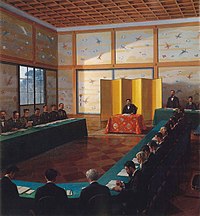Hojo Modernisation: Difference between revisions
No edit summary |
No edit summary |
||
| Line 20: | Line 20: | ||
==Centralisation== | ==Centralisation== | ||
===Industrial growth=== | ===Industrial growth=== | ||
Despite growing economic influence pushing Holterallia towards the status of a regional player in the Anterian South, the Empire's economy was still a primarily agriculture-centric affair. Lacking the maritime heritage or ability of its neighbours, Holterallia was required to rely on the merchant fleets of its clients to export much of its own considerable mineral wealth and consumable produce to the wider world. These factors -both an inclinations to pivot to a goods based market enjoyed by many of Anteria’s fledgling industrial societies, and an over reliance on foreign mercantile powers- created a new wave, of forward thinking Holterallian thought. | |||
[[File:Tokyo Industrial Exhibition.JPG|thumb|right|200px|1867 Oracloer Industrial Exhibition.]] | |||
[[File:Tokyo Industrial Exhibition.JPG|thumb|right| | |||
The rapid industrialization and modernization of Hoterallia both allowed and required a massive increase in production and infrastructure. Hoterallia built industries such as shipyards, iron smelters, and spinning mills, which were then sold to well-connected entrepreneurs. Consequently, domestic companies became consumers of international technology and applied it to produce items that would be sold cheaply in the international market. With this, industrial zones grew enormously, and there was a massive migration to industrializing centres from the countryside. | The rapid industrialization and modernization of Hoterallia both allowed and required a massive increase in production and infrastructure. Hoterallia built industries such as shipyards, iron smelters, and spinning mills, which were then sold to well-connected entrepreneurs. Consequently, domestic companies became consumers of international technology and applied it to produce items that would be sold cheaply in the international market. With this, industrial zones grew enormously, and there was a massive migration to industrializing centres from the countryside. | ||
[[Category:Hoterallia]] | [[Category:Hoterallia]] | ||
Revision as of 01:09, 20 August 2021
This article is incomplete because it is pending further input from participants, or it is a work-in-progress by one author. Please comment on this article's talk page to share your input, comments and questions. Note: To contribute to this article, you may need to seek help from the author(s) of this page. |
Hojo Modernisation (補助近代化, Hojo Kindaika), sometimes referred to as the Honourable Revival (名誉ある復活, Meiyo Aru Fukkatsu), was a transition period in Hoterallia that transformed Hoterallia from a dominant agrarian country into an industrialised empire. Hoterallia was one of the pioneers in industrialisation and modernisation as they heavily focused on the development of machine tools and the mechanized factory system.
Coronation of Emperor Hojo
After the death of Emperor Nuko, his son, Hideko Shiro was crowned as the next Emperor of Hoterallia. He was one of the most controversial princes as he views Hoterallia as running behind some countries in Anteria, he sought to make Hoterallia one of the most industrialised countries in the south.
As he ascended to the Phoenix Throne on September 1, 1798, he slowly asserted his power over both the royal cabinet, as well as the government and the military. This time also saw Hoterallia change from being a feudal, agrarian society to having a market economy and left the Hoterallian with a lingering influence of modernity and industrialisation.
Establishment of The National Diet and Constitution
In 1802, Emperor Hojo organised a meeting with his royal cabinet to discuss the creation of a constitution, as well as another government to help run Hoterallia with him. After a 5 days discussion, Hojo and the royal cabinet settled on a proper constitution draft, this draft followed the constitution of the Vultesian Empire at the time, they followed their basic structure with modifications to suits Hoterallia as well as Hoterallian characteristics.
Ita Kaida, a royal cabinet member, was appointed to research the constitution of Anteria and was also appointed to write the drafts. Many drafts were written, mostly by him with some assistance from the Emperor and the royal cabinet.
Most of the outside constitution failed to capture Hoterallian ethics as well as morality, Ita had to reject some notions, even from Vultesia. To fix this, he, therefore, added references to the Kokuseki Kisoku or "Nationality Rules" as the justification of the emperor's authority through his divine descent and the unbroken line of emperors, and the unique relationship between subject and sovereign.
Military reforms
TBA
Centralisation
Industrial growth
Despite growing economic influence pushing Holterallia towards the status of a regional player in the Anterian South, the Empire's economy was still a primarily agriculture-centric affair. Lacking the maritime heritage or ability of its neighbours, Holterallia was required to rely on the merchant fleets of its clients to export much of its own considerable mineral wealth and consumable produce to the wider world. These factors -both an inclinations to pivot to a goods based market enjoyed by many of Anteria’s fledgling industrial societies, and an over reliance on foreign mercantile powers- created a new wave, of forward thinking Holterallian thought.
The rapid industrialization and modernization of Hoterallia both allowed and required a massive increase in production and infrastructure. Hoterallia built industries such as shipyards, iron smelters, and spinning mills, which were then sold to well-connected entrepreneurs. Consequently, domestic companies became consumers of international technology and applied it to produce items that would be sold cheaply in the international market. With this, industrial zones grew enormously, and there was a massive migration to industrializing centres from the countryside.


